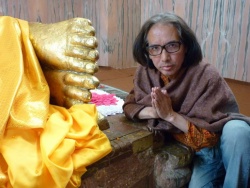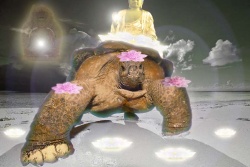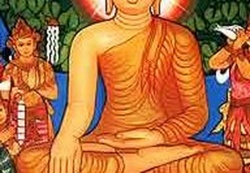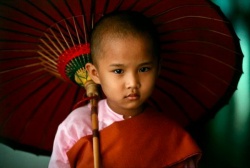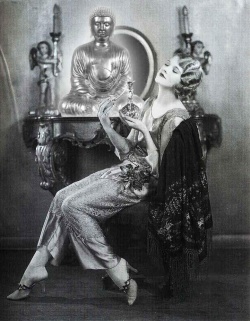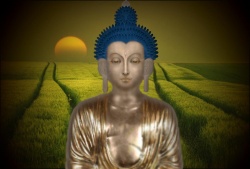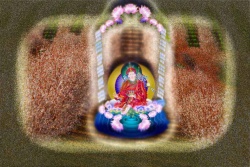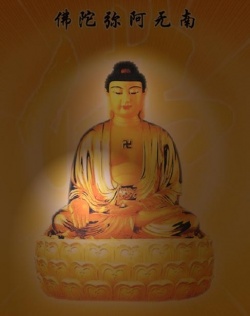Kundalini and Subtle Energies
Kundalini and Subtle Energies
Yoga invigorates all of the thousands of subtle energies within. The most potent, the kundalini is the spiritual energy that leads to higher wisdom and understanding.
Yoga works on the body at many physical and subtle levels. As we move into and hold any asana, we feel the physical sensations of the position of the skeletal structure, joints and muscles. This becomes amplified as we move deeper into a posture and especially when we focus on the breath, or imagine sending breath to the tension in the muscles.
What happens then? We might relax or feel resistance. We might become engaged in thought or feel an upwelling of emotion such as sadness, anger or gratitude. Or, a current of energy may course through an area of the body. These are experiences of the subtle body. Just as yoga affects the physical systems, it works on the subtle systems. According to the tradition of yoga, when the physical and subtle are in harmony, the individual is open to the most subtle experience-the spiritual.
A great woman yogi of the fourteenth-century, Lalli, said, ‘When the breath is steady, the mind becomes steady . . .When the breath becomes balanced, the central nerve unfolds. Then one's own essential nature and the light of knowledge manifest'.
The subtle body
The subtle body is actually not that subtle. It speaks to us, it guides us, and it directs our actions. The subtle body, for examle, converts emotional issues into physical tension, and as physical tension, it sets off an alarm of pain. Or, it might guide use into or away from a friendship by sending signals of attraction or aversion. It also is the place we consciously experience thought and feeling and the vehicle in which we experience dreams.
We are more attuned to the subtle body than might at first be apparent. One way we know our own subtle body is through observing other people. We can identify another person's subtle body, for example, when a person enters a room. He or she can have a subtle body defined by being weak or powerful, positive or negative, angry or happy, radiant or dark. We also distinguish individuals by their aura. In one sense it's a particular attitude or demeanor-the aura of triumph or generating enthusiasm, for example. It also is subtle energy that manifests as glowing colour surrounding the physical body.
Another way we know our own subtle body is through experience. For example, we can tell if we lack energy. More than simple tiredness, energy depletion comes with emotional and mental fatigue. We know when we have a burst of energy, perhaps triggered by good news, a positive feeling or sound sleep. Hatha yoga practitioners often experience a direct transformation from a dull or flat energy at the beginning of class to energy moving through the body during class and radiance at the end of class.
The spine and subtle spine
The spine and spinal cord extend consciousness from the brain, the seat of greatest awareness, to the coccyx, the seat of greatest density. The spinal cord is essential to the nervous system and the countless physical signals and processes in the body.
Likewise, the subtle spine sends and responds to all stimuli. These include all the senses engaged in the physical world, the realms of the mind and energies that both define us as a human being in a certain place at a certain time and as an essential part of universal consciousness. By focusing on the physical and outward circumstances, we remain firmly entrenched in the mundane. By focusing on the subtle body and its energies, we are released into a more spiritual experience.
Prana, the life force
In yoga the most important subtle energy is the life force itself, known as prana. Prana also means breath, as breath is the most telling manifestation of the life force and breath directly correlates to subtle energies.
The ninth-century yogic text, Shiva Sutras, says, ‘When the prana is balanced, one attains equal vision'. This means, a balanced life force and the breath itself allow an individual to experience the physical, the subtle and the spiritual with equal vision, or experience them all at the same time. Just as we can look at material objects and know they are made of vibrating molecules, the yogi can be in the physical body and know it is made of vibrating energy.
Nadis, the energy conduits
The nadis are energy currents in the subtle body that conduct the life force. The word nadi means 'flow' or 'vibration'. Some traditional yogic texts claim that each body has 72,000 nadis.
The three significant nadis universally recognized in yoga are the sushumna, the ida and the pingala. Also known as the central channel, the sushumna is located in the subtle body corresponding to the spinal column.
Representing the perfect balance of the body-mind-spirit, ida and pingala symbolise corresponding universal characteristics. The ida, located at the left of the spine, represents feminine energy, intuition, introspection and receptivity. It is symbolised by the cool moon. The pingala, which is on the right, represents masculine energy, rationality and vital power, symbolised by the hot sun. These energy currents intertwine in a helical stairway around the sushumna, meeting at each of the six lower chakras and terminating at the third eye. In many yogic traditions, hatha yoga is the process of the symbolic union (yoga) of the sun (ha) and the moon (tha).
Chakras, the energy centres
A chakra, meaning wheel, is one of seven main energy centres in the subtle body. The chakra system is both theoretical and real. To date, no X-ray machine has detected a chakra. Yet we all have experienced the very physical sensations of a knot in the stomach or a lump in the throat.
As in all the subtle energies, developing an understanding of chakras requires investigation. For example, while meditating or in daily interaction, you might notice being contracted or expanded at the area designated as a chakra. One way to investigate would be to actually ask yourself: I have a lump in my throat because I am having a hard time telling this person . . . (what?). Or, you might be chattering excitedly to someone, telling this story or that story when you are really covering up something more difficult or profound to express. Ask yourself: What do I want to say?
You also can observe how other people express their subtle energies. For example, someone proud of her daughter's recent accomplishment might be loving towards everyone, acting form an open, or expanded heart. Likewise, a person marching through a work space with a purpose might appear to be propelled into aciton by the navel and might spread a sense of urgency onto you, which you could experience as pleasant or unpleasant.
Granthi, the blocks
The ancient yogis designated three granthi, or knots, in the bioenergetic system. They represent blocks or contractions in the areas of the navel, throat and third eye. On a subtle level they are the knots of misunderstanding, such as negative emotions, doubt, lack of self-acceptance, or feeling limited or small. Yoga, meditation, contemplation and making effort towards understanding all help dispel these knots.
Kundalini, the spiritual energy
The concept of kundalini is often misunderstood. It has been attributed to anything from special breathing techniques or difficult yogic postures to madness, seizures, a malevolent force unleashed through the dark mystical arts or a brand name of Indian clothing.
Actually, kundalini is the most subtle of all subtle energies in the body, the supreme force in the human individual. As cosmic energy, kundalini is the essence of the universal spirit, or the primordial power manifest in the individual. Also known as kundalini-shakti, it simply is the spiritual energy (shakti) in a human being.
The concept of kundalini arose with the Tantras, texts and practices of the first millennium of the current era. Many of these early yogic practices were designed to help aspirants work with their bodies in order to enliven the kundalini energy. It's based on the idea that every human being is both enlivened with spiritual energy and ignorant of it.
Kundalini means coiled. It represents the dormant or ‘sleeping' potential within each of us that can be ‘awakened' into full intelligent psychospiritual power. According to tantra, this coiled-up energy remains unmanifest and is said to be a latent reservoir of psychic wisdom. When kundalini sleeps, the individual has limited awareness and perception.
When awakened to a higher spiritual plane, the individual participates in the ultimate state of harmony of the physical, subtle and spiritual, experiencing the light of consciousness and the source of light.
The Indian yogic tradition personifies the kundalini as an image of a coiled snake, wrapped three and a half times, with its tail in its mouth. This is the sleeping potential. When ‘awakened', the kundalini can rise up as quickly as a snake can strike.
Svatmarama in the Hatha Yoga Pradipika says, ‘When the sleeping kundalini awakens by favour of a guru, then all the six chakras and all the knots are pierced through. Sushumna becomes a main road for the passage of prana and the mind becomes free from all connections with its objects of enjoyments. Then the kundalini-shakti, which is the seed of the universe, unites with the prana and moves though the entire subtle and physical system, purifying all the channels and making the body strong and fit for sadhana, spiritual practice'.
By the time the kundalini reaches the third eye, it has successively penetrated the progressively more subtle chakras. Its further progression through the third eye dissolves the individual thought-waves of the mind in the state of nirvikalpa samadhi, or thought-free supreme contentment.
The awakened kundalini unites all human potential with the divine at the crown chakra, exploding into blazing white light and merging into the experience of the individual human as supreme consciousness itself.
Although the idea of the awakened kundalini might seem theoretical or way out of reach of a Western yoga student, many individuals have experienced the ‘awakening' as a sensation of energy moving through the body, associated with profound spiritual revelations.
The awakened kundalini
Like many yogic practices, the esoteric techniques of awakening the kundalini have been passed through the generations of guru and disciple. Many contemporary yoga traditions focus on awakening the kundalini, and once awakened, developing the inherent spiritual intelligence into self-realisation or enlightenment. Some kundalini practices are veiled in mystique and many are readily accessible and available today.
In the 1970s and early '80s, Swami Muktananda traveled the world, with a mission to awaken as many individuals as were interested. He said that shaktipat, or the awakening of kundalini, can occur in many different ways-spontaneously, through chanting, meditation, mantra repetition or yoga postures. Some individuals report kundalini awakening by looking at a picture of an attained yogi or reading the scriptures or certain esoteric books.
Kundalini initiation most typically involves a guru, a teacher who is filled with shakti, or spiritual power. Muktananda said, ‘In shaktipat, the shakti flows from one person to another either with or without the physical touch. The shakti flows through the nadis inside the body. When shaktipat takes place, the shakti permeates the entire body, creating a sensation similar to the heat of the fire . . . Because the shakti is subtler than the subtlest, some people may not be aware of it during the initial stages of practice. Others experience it immediately'.
People who have had a kundalini awakening report a wide variety of experiences. Along with the classic rush of energy or light along the spinal channel, other typical manifestations are sounds, visions, spiritual understanding, or insights into the nature of consciousness itself. Some burst into tears or feel a rush of bliss. Many report an ability to move the body into a yogic posture or gesture easily when before it was difficult or impossible. Still more report no particular physical association.
Deepening the spiritual experience
Swami Shankarananda was empowered by Muktananda to give shaktipat initiation. Like his teacher, he gives initiation by touch during Intensives, at his Mt Eliza ashram. He says, ‘Shaktipat is an infusion of consciousness that, operating on matter and ignorance within an individual, decisively alters the shape of his life and lifts him permanently towards the light. After shaktipat we move from strength to strength. Once the kundalini awakes, our whole experience of life is revolutionized in the most beneficent direction'.
Although the awakened kundalini is highly significant in the practice of yoga, it is considered the initiation rather than the goal. Even the most profound kundalini experiences still leave aspirants with plenty of challenges and introspection. This process of understanding and deepinging the spiritual experience is a rich journey filled with revelation and wonder.
In one of the classic books describing the kundalini experience, Devatma Shakti (Kundalini) Divine Power, [[Swami Vishnu] Tirtha Maharaj]] describes many of the attributes and processes associated with kundalini. He says, ‘When the power of kundalini awakens, the whole of the person from the physical plane upwards becomes changed and spritualised. He begins to feel the divine influence over his body, mind and intellect at all hours. He begins to feel the divine presence in himself at all hours. To such a person the divine existence is not something negative and abstract, not merely an idea, but a positive reality. He drinks deep of the divine cup and remains for all hours under diving intoxication. Such communion is the communion surpassing all other and is, therefore, named mahayoga, the highest yoga'.
As with all yoga practices, deepening the experience of subtle energies only requires steady effort and gauging progress from where we were, not in relation to another sutdent (or teacher. Whatever the practice--asanas, meditation, self-inquiry, chanting, reading or contemplation--the rewards come with consistent commitment. Intelligent investigation and continued effort in yoga always lead to higher attainment.
Focus on the Subtle Body
Like the subtle body, the subtle energies may seem elusive or even imaginary at first. The best method of working with them is to investigate for yourself.
1. Pratyahara is the practice of withdrawing attention on the stimuli from the senses and directing attention to the experience of the subtle energies. The idea is to not be affected by the outer world but to experience the inner world. As a steppingstone you can focus on the breath, the pulse, the heart or third eye (space between the eyebrows).
Where do you experience your inner world? Through the mind or the emotions? Stay in the body rather than getting drawn into thought. What do you experience beyond the sensations of the physical body? While doing yoga or meditating, spend a few moments focusing on the subtle body. What does it feel like? How far does it extend physically outward? How far does it extend subtly inward?
2. Pranayama (yogic breathing). Alternate nostril breathing, nadi shodhana, is the classic technique to connect with the left and right energy currents in the body. In a seated position, start by noticing how you feel. Scan your body and take a quick inventory of ease or tension. Then, use your right hand to gently place the pad of the thumb on your right nostril to close it. Inhale through the left nostril. Gently close the left nostril with the ring and little finger while releasing the thumb. Exhale through the right nostril. Inhale through the right nostril then close it with the thumb while releasing the left nostril. Exhale through the left nostril. Repeat to complete three, six or nine rounds. How do you feel afterwards?
3. Dharana (contemplation). Imagine the locations of the chakras in your body. Successively concentrate on each chakra from top to bottom or bottom to top. Can you determine any specific energy? If so, is there a feeling of contraction or tightness? Can you associate an emotion with any of the energy centres? If so, what is it? Is there something you can do or say to release the block? During your daily activities, occasionally stop and scan your body. If you experience tightness, try to consciously release it.
4. Dhyana (total concentration). Choose one of the energy centres for meditation. While focusing your energy on the place in the body, think of the strength associated with the chakra.
They are:
crown-transcendence;
third eye-thought, spiritual insight;
throat-communication, identity;
heart-feeling, intuition; navel-action, will, desire;
base-instinct; root-grounding, security.
caption:
The spiritual energy of kundalini travels along the subtle spine, the sushumna, blending the energies of the ida (left subtle energy) and pingala (right subtle energy), which converge at each of six chakras, or energy centres.
True spiritual insight is revealed as the kundalini merges the individual and the universal as one consciousness at the crown of the head. The body also glows with its own light, the aura.
Source
http://www.meditationyoga.com.au/australian-yoga-life/kundalini-and-subtle-energies.html
